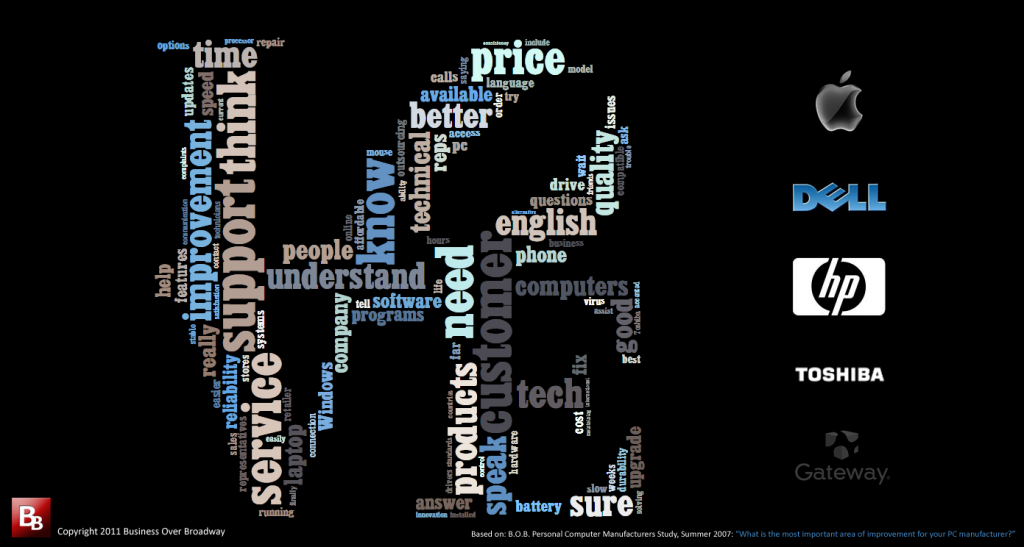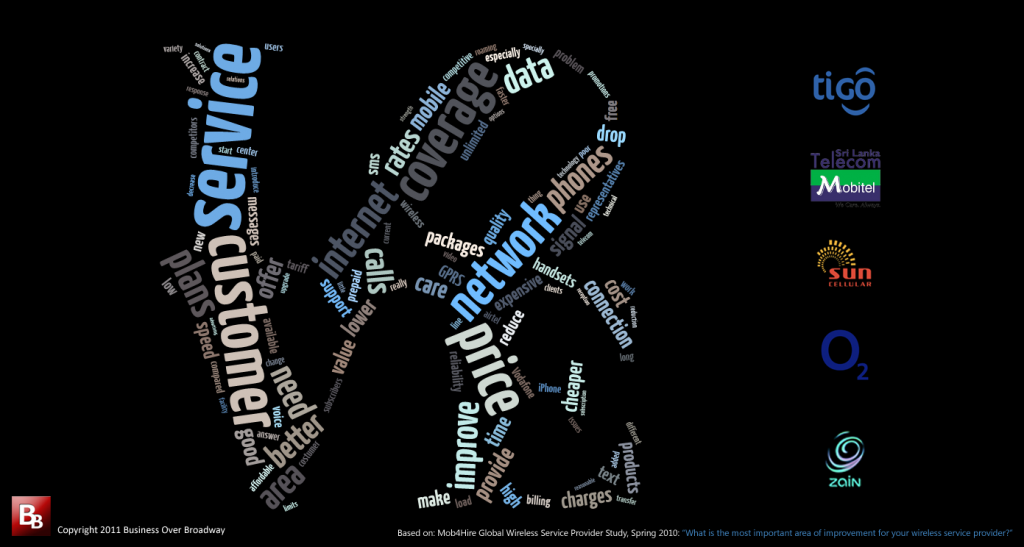I continually look for ways to present data in ways that are both informational and visually interesting. My hope is that, if scientific rigor does not capture the readers’ attention, the way in which the data are presented will.
Last month, I stumbled across the use of word clouds in survey research. Word clouds are used to visualize free form text. A word cloud is a collection of words individually weighted by size that reflect the frequency of occurrence of that word within the body of the text. Word clouds are also referred to as tag clouds or “weighted lists” (see wikipedia.org). While the visual appearance or layout of a word cloud can be driven by various properties of the words (list words alphabetically, randomly, by size), other non-word-related properties can be used to enhance the word cloud (font color, intensity, present words horizontally and vertically).

Figure 1. Business Over Broadway: It's All About The Customer - Based on Web site content. Click image to enlarge.
The aforementioned word cloud on which I stumbled last month reflected the summary of a one-question survey that required a one-word answer. The resulting word cloud of answers was essentially an artful frequency distribution of each answer (the larger the font size, the more frequently that word was mentioned by respondents). The combination of form, color, size, and positioning of words worked well to keep my attention.
After a quick search, I found two sites (wordle.net and tagxedo.com) to help me generate word clouds. I have included a few here to illustrate different applications of word clouds in VoC programs.
Example 1: What do you do?
I created a word cloud using the content from my Web site. Figure 1 is the result of one of the word clouds that was generated by wordle.net. This picture, I thought, was a creative way to convey what I do. I use this word cloud to quickly convey my professional interests to customers and prospects in a visually stunning way. What will you find if you generate a word cloud on your company’s VOC documentation?

Figure 2. Personal Computer Manufacturers: Getting to Love - Based on B.O.B. PC Manufacturer Study of US Consumers, Summer 2007. Click image to enlarge.
Example 2: Personal Computer Manufacturers: “Getting to Love”
A few years ago, I conducted a survey of about 1000 US consumers on their experience with their personal computer. In addition to structured customer loyalty and customer experience questions (provided quantitative ratings), the survey included one open-ended question that asked the respondent, “What is the most important area of improvement for your personal computer manufacturer?” The resulting word cloud of the responses is presented in Figure 2. I call this word could, “Getting to Love,” to convey what PC manufacturers need to do to get customers to love them. I included the brand logos of the major PC manufacturers that were represented in the survey; they are ranked, top-down, based on their loyalty ratings from the survey.
Example 3: Wireless Service Providers: “Getting to Love” and “They Can’t Build an App for That”

Figure 3. Wireless Service Providers: Getting to Love - Based on Mob4Hire Global Wireless Service Provider Study, Spring 2010. Click image to enlarge.
Mob4Hire, a global crowd-sourced testing and market research community, and I conducted a worldwide survey to assess loyalty toward wireless service providers. A total of 5686 “Mobsters” completed the web-based survey. Similar to the study above, the survey included one open-ended question that asked the respondent, “What is the most important area of improvement for your provider?” Using the responses to this question (and with the help of Photoshop), The “Getting to Love” word cloud for this questions appears in Figure 3.
I created another word cloud to satisfy the creative urge in me. Using the same text, I generated a simple word cloud, created an image of a generic smartphone (Thank you, Photoshop!) and put together the image in Figure 4. I call this one: “You Can’t Build an App for That.”

Figure 4. Wireless Service Providers: You Can't Build An App for That - Based on Mob4Hire Global Wireless Service Provider Study, Spring 2010. Click image to enlarge.
Drive Interest in the Voice of the Customer
Supporting your statistical analyses with a visually stunning representation of your customers’ comments goes a long way in generating interest in your VoC program. Capturing the essence of customer sentiment, customer-based word clouds can be used to facilitate group discussions about the customer and help communicate survey results throughout the company.
I have already incorporated word clouds into reporting customer relationship survey results (See Customer Relationship Diagnostic). While they are not meant to replace a more thorough examination of text content using text analytic methods, customer word clouds are an excellent complement to the more statistically rigorous methods.
Word Clouds for Building a Customer-Centric Culture
I think that the main benefit of using word clouds in VOC programs is one of efficiently communicating a customer-centric culture to all constituencies. I recall how Siebel Systems used customer-related art work for their offices to keep the customers in the minds of all employees (Customer logos, magazine covers highlighting customers and even customer commendation letters about a company employee were all used as artwork throughout Siebel Systems buildings.). Word clouds of customers comments can play a similar role.
Maybe you will think of other ways to integrate word clouds into your VOC program. If you try, please let me know how you use it.



 Beyond the Ultimate Question
Beyond the Ultimate Question Measuring Customer Satisfaction and Loyalty (3rd Ed.)
Measuring Customer Satisfaction and Loyalty (3rd Ed.)
[…] impetus of this question was purely artistic. I use the responses to this question to generate word clouds. A word cloud is a collection of words such that the size of the words is associated with the […]
[…] I generated a word cloud using all the predictions (see Figure 1.). Second, I conducted a content analysis by grouping […]
[…] they are ambiguous and unnecessary. Consider using visually stunning ways to present your data. A visually stunning presentation of the data, compared to bar graphs, will more likely be examined by the consumers of your reports. Click […]
[…] Getting to Love: Customer Word Clouds […]
[…] interesting. Bar charts are boring. I know because I make them. Consider employing the use of word clouds to summarize the customers’ open-ended comments. Word clouds let you present frequency data […]
[…] To some degree, I have Steve Jobs to thank for that. To honor him and his legacy, I created the word cloud you see in this post, combining the words used to describe him after his passing with the image of […]